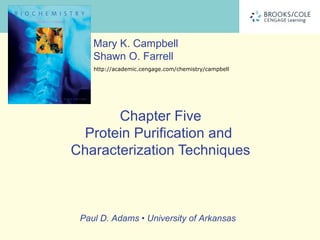
Protein purification chp-5-bioc-361-version-oct-2012
- 1. Mary K. Campbell Shawn O. Farrell http://academic.cengage.com/chemistry/campbell Chapter Five Protein Purification and Characterization Techniques Paul D. Adams • University of Arkansas
- 2. Why purify a protein? • Characterize function, activity, structure • Use in assays • Raise antibodies • many other reasons ...
- 3. Guidelines for protein purification • Define objectives • Define properties of target protein and critical contaminants • Minimize the number of steps • Use a different technique at each step • Develop analytical assays Adapted from: Protein Purification Handbook. Amersham Biosciences. 18-1132-29, Edition
- 4. How pure should my protein be? Application Required Purity Therapeutic use, in vivo Extremely high > 99% studies Biochemical assays, X-ray High 95-99% crystallography N-terminal sequencing, antigen for antibody Moderately high < 95% production, NMR
- 5. Separation of proteins based on physical and chemical properties • Solubility • Binding interactions • Surface-exposed hydrophobic residues • Charged surface residues • Isoelectric Point • Size and shape
- 6. The overall goal • To remove as much of the “other” protein as possible and keep as much of your target protein as possible • This is a great challenge since at each step you sacrifice some of your target protein. • Activity = total target protein activity in your sample • Specific activity = how much target enzyme activity you have with respect to total protein content present • Which number should go up and which down?
- 7. Activity versus Specific Activity Enzyme activity • Enzyme activity = moles of substrate converted per unit time = rate × reaction volume. Enzyme activity is a measure of the quantity of active enzyme present • 1 enzyme unit (U) = 1 μmol min-1 Specific activity • The specific activity is the activity of an enzyme per milligram of total protein • expressed in μmol min-1mg-1. • Specific activity is equal to the rate of reaction x volume of reaction / mass of total protein.
- 8. How We Get Proteins Out of Cells
- 9. Proteins/enzymes are delicate • Remember Proteins are delicate and subject to denaturation. • Often tracking a protein based on its activity or function therefore it needs proper conformation • Cells are full of hydrolytic enzymes when you fracture or lyse a cell proteins and enzymes are mixed and degradation occurs immediately • Keep things cold (on ice) • Add protease inhibitors • Many considerations to be made when using and selecting protease inhibitors – remember the six classes of enzymes – don’t want to inhibit and enzyme activity when need to assay during the purification
- 10. How will you track your protein? • Purification is often a multi-step process • You need to track or “assay for your protein” after each step • If it is an enzyme you can test for its activity • If you have an antibody you can use Western blot or ELISA • You can test for its size (not as specific) • You could use mass spectrometry to identify it • You could use N-terminal sequencing to ID the traget protein
- 11. Salting Out • After Proteins solubilized, they can be purified based on solubility (usually dependent on overall charge, ionic strength, polarity • Ammonium sulfate (NH4SO4) commonly used to “salt out” • Takes away water by interacting with it, makes protein less soluble because hydrophobic interactions among proteins increases • Different aliquots taken as function of salt concentration to get closer to desired protein sample of interest (30, 40, 50, 75% increments) • One fraction has protein of interest
- 12. Column Chromatography • Basis of Chromatography • Different compounds distribute themselves to a varying extent between different phases • Interact/distribute themselves • In different phases • 2 phases: • Stationary: samples interacts with this phase • Mobile: Flows over the stationary phase and carries along with it the sample to be separated
- 14. Ion Exchange • Interaction based on overall charge (less specific than affinity) • Cation exchange • Anion exchange
- 15. Size-Exclusion/Gel-Filtration • Separates molecules based on size. • Stationary phase composed of cross-linked gel particles. • Extent of cross-linking can be controlled to determine pore size • Smaller molecules enter the pores and are delayed in elution time. Larger molecules do not enter and elute from column before smaller ones.
- 17. Affinity Chromatography • Uses specific binding properties of molecules/proteins • Stationary phase has a polymer that can be covalently linked to a compound called a ligand that specifically binds to protein
- 18. Electrophoresis • Electrophoresis- charged particles migrate in electric field toward opposite charge • Proteins have different mobility: • Charge • Size • Shape • Agarose used as matrix for nucleic acids • Polyacrylamide used mostly for proteins
- 19. Electrophoresis (Cont’d) • Polyacrylamide has more resistance towards larger molecules than smaller • Protein is treated with detergent (SDS) sodium dodecyl sulfate • Smaller proteins move through faster (charge and shape usually similar)
- 20. SDS PAGE – to track your purification
- 21. Isoelectric Focusing • Isolectric focusing- based on differing isoelectric pts. (pI) of proteins • Gel is prepared with pH gradient that parallels electric- field. What does this do? • Charge on the protein changes as it migrates. • When it gets to pI, has no charge and stops
- 22. 2D gel – Size and Isoelectric point Silver or commassie blue stain ---- Sypro Ruby - fluorescent
- 23. Differential Centrifugation • Sample is spun, after lysis, to separate unbroken cells, nuclei, other organelles and particles not soluble in buffer used • Different speeds of spin allow for particle separation
